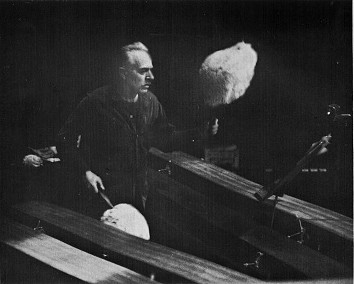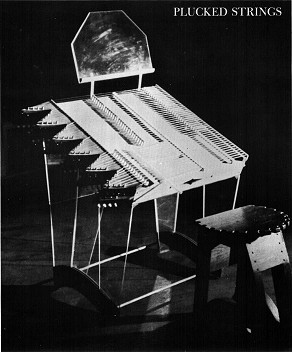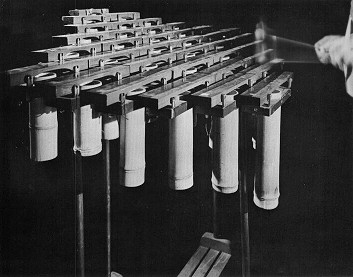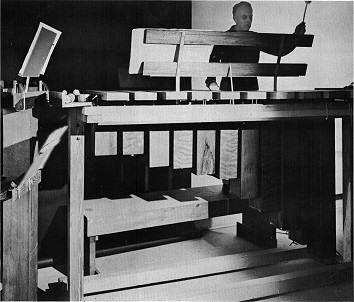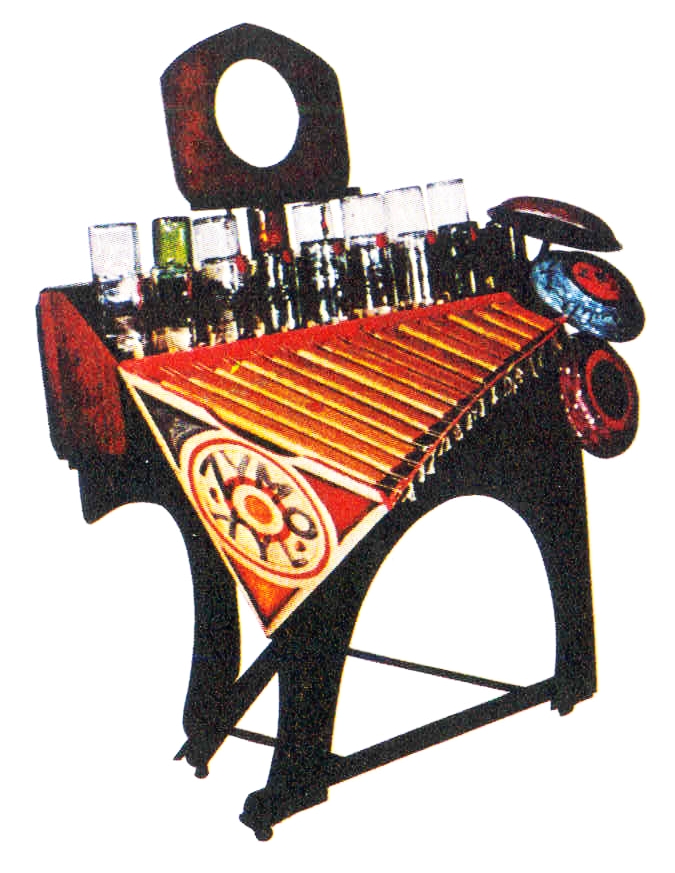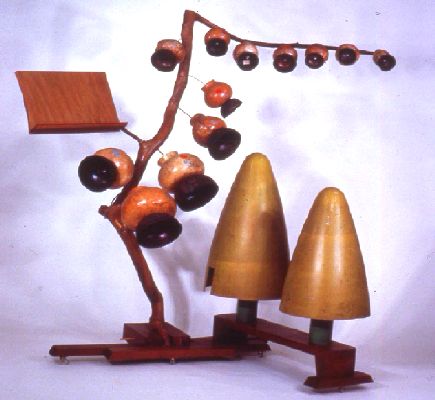Harry Partch (June 24, 1901 – September 3, 1974) was an American composer, music theorist, and creator of musical instruments. He was one of the first 20th-century composers in the West to work systematically with microtonal scales. He built custom-made instruments in these tunings on which to play his compositions, and described his theory and practice in his book Genesis of a Music (1947).
Partch composed using scales of unequal intervals in just intonation, derived from the natural Harmonic series; these scales allowed for more tones of smaller intervals than in the standard Western tuning, which uses twelve equal intervals to the octave. Partch divided the octave into 43 unequal tones. To play this music, he built a large number of unique instruments, with names such as the Chromelodeon, the Quadrangularis Reversum, and the Zymo-Xyl.
Partch focused on ideals of monophony and corporeality, in contrast to the abstract, polyphonic music prevalent at the time. His earliest compositions were small-scale pieces to be intoned to instrumental backing; his later works were large-scale, integrated theater productions in which he expected each of the performers to sing, dance, speak, and play instruments. Ancient Greek theatre and Japanese Noh and kabuki heavily influenced his music theatre.
PARTCH' S INSTRUMENTS
Partch called himself "a philosophic music-man seduced into carpentry". The path towards Partch's use of a large number of unique instruments was a gradual one. Partch began in the 1920s using traditional instruments, and wrote a string quartet in just intonation (now lost).
Adapted viola
He had his first specialized instrument built for him in 1930—the Adapted Viola, a viola with a cello's neck fitted on it. He created the fingerboard in 1928, but it wasn't until two years later while in New Orleans that he hit upon the idea of putting it on a viola's body.
Adapted Viola (photo by Fred Lyon)
The instrument consists of an average-size viola soundbox with a neck and fingerboard that is six inches longer than usual. The tuning pegs are from a cello, as are all the strings except the first, which is a double-length violin first string. Instead of frets, the fingerboard is marked with a series of brads hammered in beside the strings to mark the various pitches, 37 to the octave at this point in Partch's career. As you can see, the Adapted Viola is played with a bow and the instrument is held between the legs. The Adapted Viola’s range is expanded from the traditional viola to rest between the cello’s and the violin’s.
Partch’s work at this time was mostly compositions for voice accompanied by the new invention, among them the 17 Lyrics of Li Po, settings of Biblical Verses, and Shakespeare.
Adapted Guitars
Adapted Guitar I. Built in 1934
In 1945, he adapted a guitar with a smooth and narrow fingerboard by adding pinheads and brass rivets and filing them down to be equal to the the fingerboard's level.
That same year, Partch adapted a Hawaiian guitar, complete with a plastic rod to make gliding pitches possible. While the six strings of the first two guitars were tuned in three pairs of octaves (2/1), each a third (5/4) apart, the ten strings of the third guitar are tuned according to one of Partch's hexads.
He couldn't call all three instruments "Adapted Guitar," so he started calling the second guitar Adapted Guitar I, the Hawaiian guitar Adapted Guitar II, and the original guitar Adapted Guitar III. But in 1956, he gave up on the second guitar and renamed the original guitar Adapted Guitar I.
Chromelodeons
Chromelodeons. Built in 1945
He re-tuned the reeds of several reed organs and labeled the keys with a color code. The first one was called the Ptolemy, in tribute to the ancient music theorist Claudius Ptolemaeus, whose musical scales included ratios of the 11-limit, as Partch's did. The Ptolemy broke during shipping back to the states and he abandoned it in favor of the Chromelodeon. The Chromelodeon is used in most of Partch’s works. It is an old Harmonium that has had all of its reeds removed and retuned to Partch’s original 43-degree monophonic system. The keyboard is only changed in the fact that the keys are painted and the ratios representing their pitch is indicated on the key.
Part of the keyboard of the Chromelodeon
Kithara
In 1938, he built his first Kithara, an alto version of the instrument, and began using it in his Americana compositions almost immediately. It was a large instrument, almost six feet tall, and served him well until 1952, when he restrung and retuned it. In the process of adapting the Kithara I, he realized he wanted more bass resonance, and so, in 1954 in Sausalito, California, he built the seven-foot tall Kithara II as a bass instrument.
By 1972, he decided to replicate the Kithara I in order to make a stronger, more playable instrument that had increased resonance. As he often remarked, he didn't have 200 years of manufacturing know-how behind him as piano makers do, so he needed a little trial and error to sort things out.
Marimba Eroica
This is one of Partch’s most interesting instruments, a 4 note marimba which produces very low tones. Each note is roughly the size of an upright piano, the resonators being large empty plywood boxes and the block a long redwood timber suspended on foam. The mallets are very large and weigh about 4 pounds each.
The Harmonic Canon
The Harmonic Canon. Built in 1945. Photo by Danlee Mitchell
Diamond Marimba
When Partch arrived in Madison, Wisconsin, He set to work adding some "rhythmic interest" by creating percussion instruments. One of the first fruits of this new focus was the diamond marimba.
The Diamond Marimba. Built in 1946. Photo by Fred Lyon
Before
describing that instrument, We need to make a slight detour. One of
Partch's great contributions to microtonal theory was his formulation of
the tonality diamond. In the diamond, he took his starting pitch (a G
for him) and built chords of six pitches above it following the overtone
series to the 11th limit (which he called otonalities) and then built
chords of six pitches flipping the overtone series and going down (which
he called utonalities). He then arranged these in a diamond shape with
the starting pitch (that G) in the middle and the otonalities moving up
towards the right and the utonalities moving down towards the right,
resulting in 29 pitches altogether. It looks like this:
Here's "The Waterfall." You'll hear the diamond marimba make runs as well as the sweeping chords that are its most distinguishing characteristic:
The Quadrangularis Reversum
The Quadrangularis Reversum. Built in 1965
Is a later development of Partch’s Diamond Marimba, an instrument that illustrated his theory in its design. “This instrument is the theoretical Tonality Diamond brought to practical tonal life.” The diamond has at its lower point the 1/1 ratio, and extends to the right with Otonalities, and to the left with Utonalities. (the overtone series, Otonality, and its inverse Utonality).
The Bass Marimba
The Bass Marimba. Built in 1950
The Boo (Bamboo Marimba)

The Boo. Built in 1955-1956. Photo by Steve Hockstein
The Cloud Chamber Bowls
The Cloud Chamber Bowls. Built in 1950-51.
The Cloud Chamber Bowls are fourteen sections of 12 gallon Pyrex carboys, suspended from a redwood frame in seven vertical lines by rope and s hooks. The original carboys used were found at the Radiation Laboratory glass shop at the University of California, Berkeley in 1950. “I discovered that a very beautiful but complex sound could be produced if the center of a section was suspended by one hand, so that the edge was free, while the other hand struck with fingertips on the edge. As long as my experiments went on, I undoubtedly deprived various faculty wives of many punch and fish bowls.”
The Mazda Marimba
The Mazda Marimba. Built in 1955-1956.
The Xymo_ Xyl
The Zymo-Xyl. Built in 1963
The Zymo-Xyl is an oak-block xylophone augmented with tuned liquor and wine bottles, Ford hubcaps, and an aluminum ketchup bottle. The name is from the Greek zymo- for "fermentation", and xylo- or xyl- for "wood
A dozen Chinese temple bells were bolted to gourds of equal pitches and affixed to a large eucalyptus bough. The two large cone gongs (nose cones from airplane gas tanks) are supported from the floor by a different base.
Throughout his life, Harry Partch was faced with resistance to his revolutionary and controversial ideas. His theories, writings, instruments, music and life can be seen as one unified act of transcendence, subversion and defiance. His struggle was nothing less than the millennia old fight against the expropriation of man through the development of autonomous technology and the destruction of nature. Partch ruled the technology required to complete his creative vision, a vital art, which never compromised its core of primitive sexual impulse, subversive to all systems of indoctrination and those that seek to regiment or commodify the creative spirit.In 1990, Dean Drummond's Newband became custodians of the original Harry Partch instrument collection, and the group performs with and commissions new pieces for the instruments.The instruments have been housed in the Harry Partch Instrumentarium at Montclair State University in Montclair, New Jersey since 1999. In 2004, the instruments crossed campus into the newly constructed Alexander Kasser Theater, which provides a large studio space in the basement. Concerts by Newband and MSU's Harry Partch Ensemble may be viewed several times a year in this hall. Those who have duplicated partial sets of Partch instruments include John Schneider, whose West Coast ensemble includes replicas of the Kithara, Surrogate Kithara, Cloud-Chamber Bowls, Adapted Guitars, Adapted Viola, Diamond Marimba, Bass Marimba, Chromelodeon, and two Harmonic Canons.
Sources:
http://sonicgranades.blogspot.com.es
http://marcjwolf.com/articles/harry-partch-america-s-first-microtonal-composer/
http://www.corporeal.com










